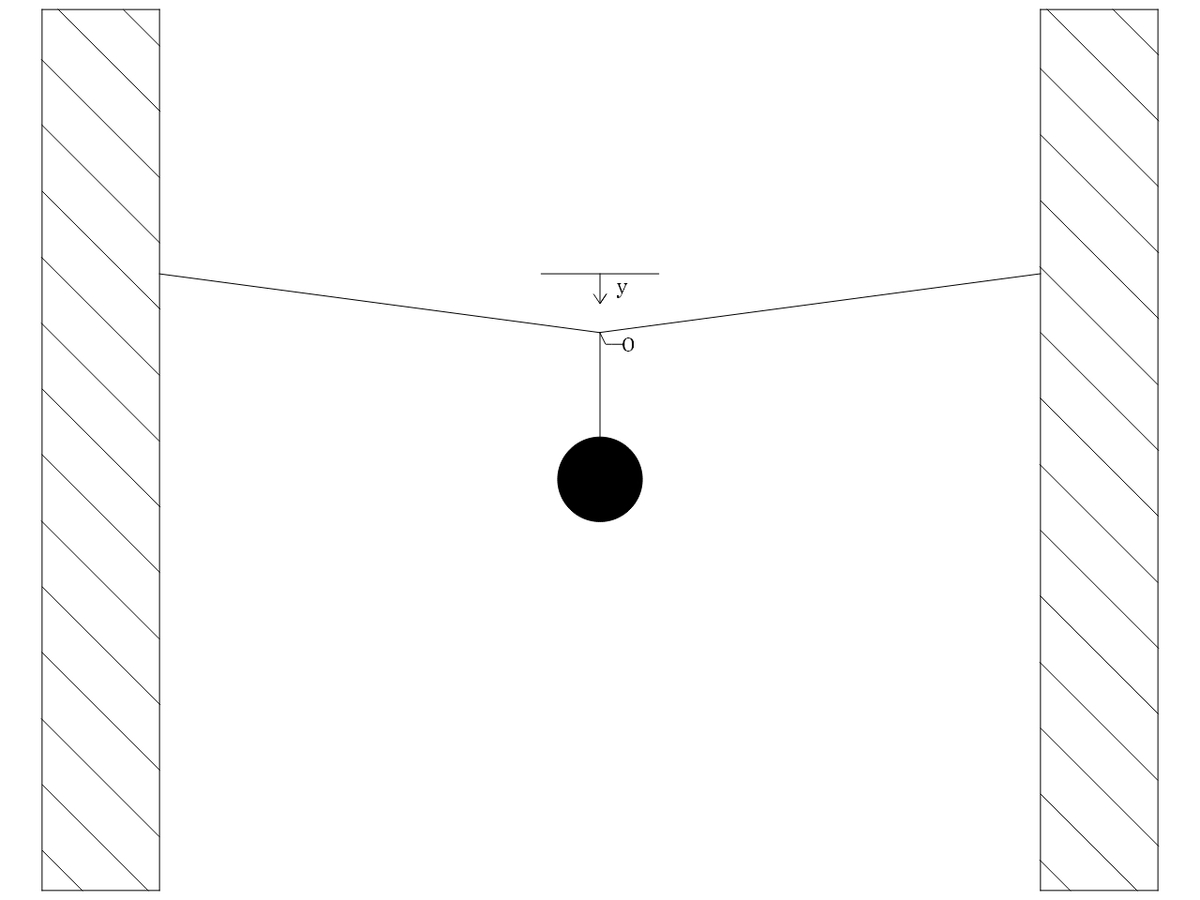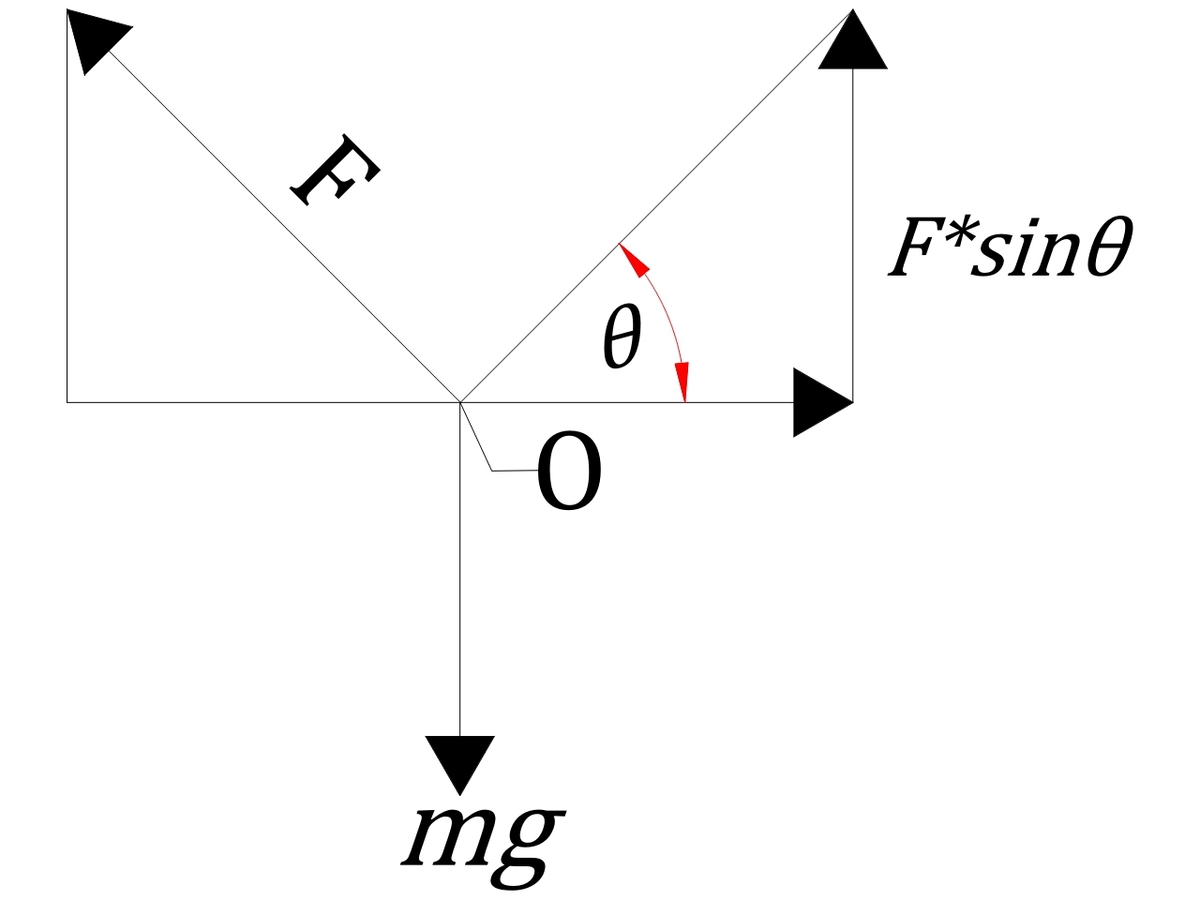String Tensions
Charlie hangs a string horizontally between two walls and uses an identical string to hang weights vertically.
As he adds weights, the tensions in both strings increase.
Which string will break first?
Assume that the string is made from ordinary twine, which stretches minimally under tension.
This section requires Javascript.
You are seeing this because something didn't load right. We suggest you, (a) try
refreshing the page, (b) enabling javascript if it is disabled on your browser and,
finally, (c)
loading the
non-javascript version of this page
. We're sorry about the hassle.
9 solutions
This explanation is invalid. Each point of the vertical string feels the same tension of the full weight, there is no distribution of tension.
This explanation is too simple. The tension on the (near)-horizontal rope depends on its angle deviating from horizontal. Indeed, for some angles the vertical rope will have more tension, while for other angles the (near)-horizontal rope will have more tension.
https://physics.stackexchange.com/questions/207984/confused-on-how-tensions-can-differ-with-angle
I don't believe that strictly math or reasoning can predict the outcome in all cases. Neither of them take in to account the actual material and construction of the string itself. e.g. Cotton fibre string vs paracord.
Nice but if the horizontal string breaks the vertical string will not break because there is no longer any strain on it. So the horizontal string can not break "first" since the vertical string will not break at all. More properly phrased, "Which string will break?"
I think that the horizontal string is carrying some more weight than the vertical string(weight of the hook) and should break first.
draw a free body diagram. the horrizontal string will sag a bit but the force vector takes the weight that is W=2×F×sin(1°) so F force in string would need to be high in order take weight W with a low angle like 1 degree
But realistically speaking the angle wouldn't be 1 degree would it? As the angle gets past 30 degrees there would start to be less tension on the horizontal string than the vertical. Whether the rope would stay at a low angle or sag past more than 30 degrees would depend on the elasticity of the rope.
It seems to depend on how stretchy the strings are. Tension in vertical string is mg Each side of horizontal string has vertical component mg/2 = T sin(a) where a is the angle the string dips by and T is the tension. This allows T in the horizontal string to be less than mg for angles exceeding 30 degrees. This will happen if the strings stretch by more than a factor of 2/sqrt(3) before breaking.
This is the correct explanation.
Log in to reply
I believe you. When I have more time I will analyze it further. Thank you, Richard.
I've added an assumption about the material the strings are made from.
The answer depends on the angles between the strings at the junction, which in turn depend on how much slack the upper (it's never truly horizontal) string has initially and how much it stretches under tension.
When the upper string is almost straight, as in the illustration, it has a very high tension and breaks first.
If the strings form three angles of 120 degrees each, the strings have the same tension and break at the same time. If the upper string gets even longer (if it hangs very low, it can effectively almost double itself), then the lower string has more tension and breaks first.
Your explanation is actually very good, but I think this only applies if there would be two strings connected in the middle. The force that goes in both directions of the "horizontal" string are still at the same string, so in any geometry, they add up to a greater value than the force on the lower string, don't they?
Does anyone find it odd that the tension in the string increases to infinity at the slightest onset of loading? Without accounting for the elasticity of the string the mechanics don't strictly forbid you from independently varying the angle theta in such a way that a mere feather weight loading would create a massive unphysical force.
Figure 1. shows the original problem setup in a state of deflection when under loading.
 Figure 1
Figure 1
The "y" coordinate measures the sag from the horizontal datum to point O.
Begin by summing the forces in the "y" direction, about the point O. Figure 2 is the breakdown of the vector components.
 Figure 2
Figure 2
∑ F y = 2 F s i n θ − m g = m d t 2 d 2 y …Eq1
The position of equilibrium can be found from setting d t 2 d 2 y = 0
From here the materials stress-strain response must be found. Assuming the string is in the region of deflection where all deformations are elastic, the stress can be related to the strain by the materials Modulus of Elasticity ( assumed constant ) via:
d σ = E d ϵ ...Eq2
where,
σ = Normal Stress
ϵ = Strain
E = Modulus of Elasticity
or equivalently put, assuming a constant cross-sectional area.
d F = E A d l / l ...Eq3
Next, relate the strain to the angle theta as shown in Figure 3.
 Figure 3
Figure 3
Then from vector addition,
( l + d l ) − l = l d θ → l d l = d θ ...Eq4
Now change variables by substituting Eq4 into Eq3.
d F = E A d θ ...Eq5.
Integrate Eq5 to give:
∫ 0 F d F = E A ∫ 0 θ d θ → F ( θ ) = E A θ ...Eq6
Substitute Eq6 into Eq1' to find the angle of equilibrium.
2 E A θ s i n θ − m g = 0 …Eq7
From here apply the small angle approximation for s i n θ ≈ θ and Eq7 becomes:
2 E A θ 2 − m g = 0 → θ = 2 E A m g
Finally, we can go into Eq1 and solve for the tension force F when the system is in static equilibrium:
F = 2 s i n θ m g , but now (after the introduction of elasticity) it is apparent that theta has other dependencies (including the mass). So if we want to see what happens when we let the mass tend to zero we can again use the small angle approximation s i n θ ≈ θ and,
F ≈ 2 θ m g = 2 2 E A m g m g
You can then apply L'Hopital's Rule to find the limit as the mass approaches zero.
m → 0 lim F = m → 0 lim 2 2 E A m g m g = C o n s t a n t m → 0 lim m m = C o n s t a n t m → 0 lim m = 0
Most importantly, the relationship shows the tensile force in the supporting ropes are dependent on the materials Modulus of Elasticity. For some MoE, the angle theta may meet or exceed 30 degrees ( θ 2 approximates θ s i n θ well up until about 40 degrees) at which point the forces in all both ropes may be equal and snap, or they angle may exceed 30 degrees and the lower rope may snap. The problem is not stated properly, and no solution can be determined.
it does make sense tho. if you barely bend you must have a helluva tension to support a directly vertical force
Note to Eric Roberts : In vectoral definition, Horizontal force = Vertical force / Sin alfa (horizontal bending angle) When alfa approaches to zero, sin alfa becomes zero too. Thus HF = VF / 0 = Infinity. If you want the horizontal string NOT to sag AT ALL (zero bending), it must be strong enough to bear infinite force, which is hypothetical.
A fly lands on a structural steel I-beam in this manner. Suddenly the axial loading is infinite, and the beam ruptures? I think not. So what we probably have is model that is severely lacking in describing the reality. So what is the appropriate model?
The horizontal string will have sheer stress. The vertical string won't.
(We take it as the strings are the same property and density in this problem).. Well they added it. 6dd/8mm/2019
The thing is that in both the strings , the net force is obviously zero . But in the verticle 2 opposite Mg force are canceling each other (one is T1=Mg) And in the case of horizontal string , there are 3 force acting Mg and 2 from the wall . And using 2nd law , you can show that the tension due to wall is , say , T2=Mg/2cos(x) , where x is the angle of depression . SO it is due to this greater forces , the horizontal string should break first.
The tension of the weights are concentrated into a single point of the horizontal string and the vertical has the tension distributed all along it.
Say the weight hangs from the horizontal string. In order for the string and weight to be at rest, the forces on that point must sum to zero.
Tension, though, acts along the string. I’ve called the angles that the string makes with the horizontal A and B.
The string angles to the horizontal could be equal, but need not be in the more general case. What must happen, though, is for the tensions to sum to the forces. So we have
F1 = mg = T1 ,
F1 = mg = T2 sin(A) + T3 sin(B) , and
T2 cos(A) = T3 cos(B) in order to keep the point stationary.
Now, if angles A and B are equal, then
T = T2 = T3
That’s the case in the problem as posed. Furthermore, if the angles A and B are small, then to a good approximation
A = B = sin(A) = sin(B)
So, we have
F1 = mg = 2AT , or
T = F1/2A
To put some numbers to this, say that A = 1 degree. That is, A = 2π/360 so that
T = 30 F1 , approximately, at a sag of 1 degree.
Just eyeballing it/feeling it , the horizontal fails, the weights swing sideways against the wall
Formulas aren't actually necessary to figure out the answer.
The strain on the vertical string is the same throughout the entire string, while the strain on the horizontal string will be focused around a single point. Since the tension on that point will be greater than any other point on the vertical string, and either string will break when a point on that string gets to a certain tension, the horizontal string will reach that certain tension first and break.